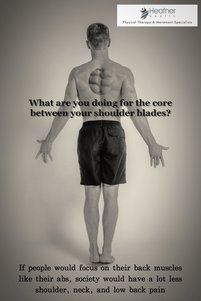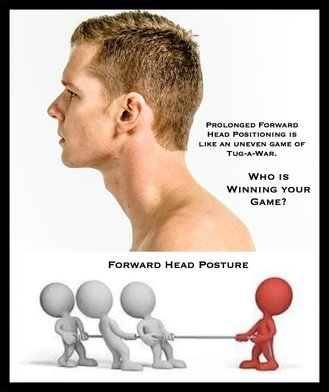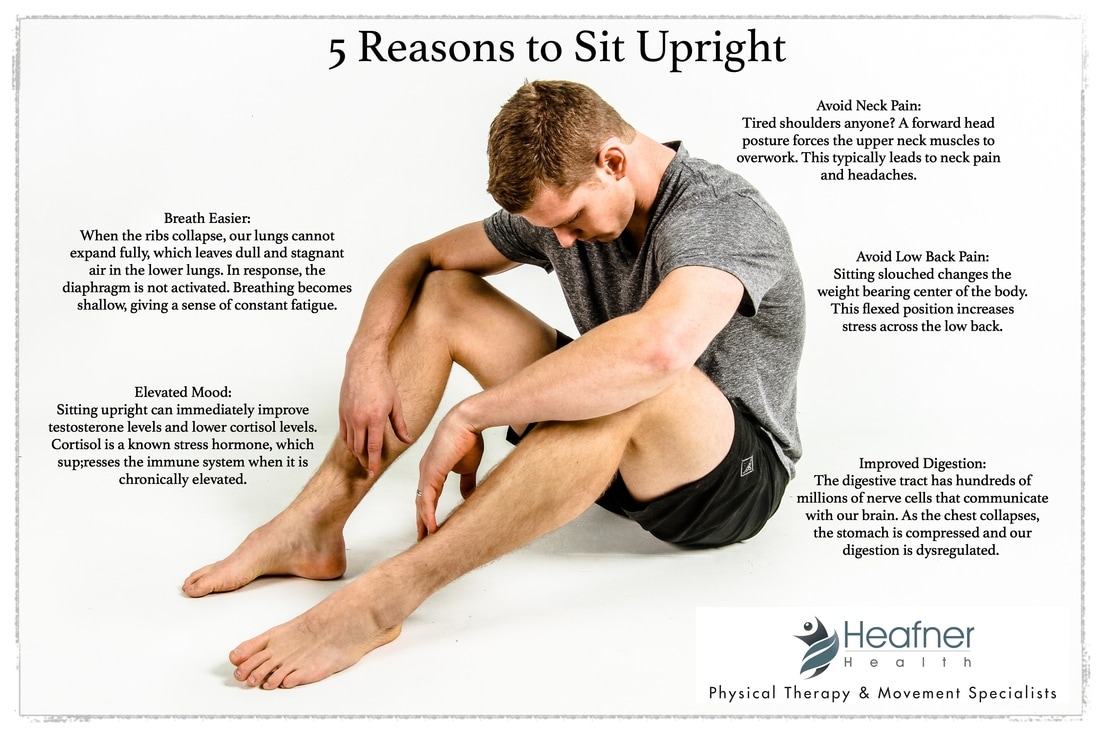Look in a mirror right now. Where is your head resting in relation to your shoulders?If your head posture looks similar to the picture above, you have a resting forward head posture. While this position is not inherently bad, a prolonged forward head posture often leads to neck pain and headaches. With my clients, I compare the forward head posture to a game of Tug-A-War between your neck muscles. In this game, the muscles on the front side of your neck are actively fighting against the muscles on the back side. If the head is positioned forward, the force of gravity makes the back muscles work significantly harder, often losing the game. In this post, we will cover the forward head posture, reasons to sit upright, and specific exercises to minimize neck pain and headaches. Reasons to Sit UprightThe other day, I was reading a book about the Alexander Technique. In the book, the author tells a story about a young boy who is sitting upright and alert in his classroom. The boy is wide awake, unlike his fellow classmates. However, despite the boy's attentiveness, the teacher scolds him and tells him to sit down because he is blocking the other children's viewpoint. The boy slouches, matching the posture of the rest of the class. Within minutes, his demeanor was tired and withdrawn. This story is important for several reasons. First, sitting upright changes our mood. When the boy slouched, he became removed from his present learning environment. This shows that sitting upright can literally change our biochemistry. Our posture changes how hormones are regulated in our body. Second, the teacher's response to his posture shows that our society has conformed to the slouched, tired posture. Aside from changing our mood, sitting upright has positive effects on our spine, breathing pattern, and digestion. In the picture above, both my middle and lower back are rounded excessively. If the low back is rounded for long periods of time, extra stress is placed across this region. In this example, the hips no longer absorb the weight of the body, but rather the lower back absorbs this stress. When the middle back slouches, the head and neck must readjust by jutting forward so that our eyes can meet the world again. The above statements are very concrete. We can see and feel those differences simply by changing our posture. More abstract changes happen beneath the surface. For example, slouching forward from the middle back effects our respiratory and digestive systems too. As the upper back rounds forward, our upper ribs move closer together and the diaphragm has trouble assisting with the breathing movement. Other neck muscles take on new roles for breathing and become overworked. Decreased respiration leaves carbon dioxide in the lower lobes of the lunges and oxygen is not transported fully throughout the body. Additionally, the increased compression on the abdomen creates tension in the stomach and intestines, altering digestion. What Can We Change Today First off, it is important to note that having good upright posture will not solve all life's problems. As I tell my patients, "Your next posture is your best posture!" In other words, movement is the key to longevity. Movement almost always trumps static posture. However, being cognizant of maintaining an upright posture is beneficial. There are simple, daily steps that can be taken to have better resting posture. One important region to pay special attention is the middle back. As I discuss in a previous post on the middle back, "The thoracic spine - or middle twelve vertebrae of the spine - connect the neck to the low back. Anatomically this region moves less than its counterparts. The neck is designed for high amounts of movement in order to quickly look or turn. On the contrary the thoracic spine is built for stability. It houses the connections for the ribs, which protect the vitally important organs of the heart and lungs... A lack of motion forces the higher and lower connections (neck and low back) to move excessively. The excessive movement causes small amounts of repetitive trauma in the neck and low back eventually resulting in pain. " Below are two videos that provide a mix of mobility (a.k.a maintaining motion) and stability (engaging the shoulder blade) muscles. These exercises will help you sit more erect and maintain a healthy, upright posture!
Do you have neck pain? Check out Heafner Health's Top 5 exercises to treat neck pain while typing!
5 Comments
Manuel Franco
8/29/2023 10:31:03 pm
I just want to say Thank You to everyone who supported me through the years. My name is Manuel Franco, New Berlin, Wisconsin. My story of how I won the Powerball lottery of $768.4M is a bit of a tale. I have been playing Powerball tickets for 6 years now since I turned 18. I bought my first ticket on my 18 birthday. I was feeling very lucky that day because I had contacted Dr. Odunga Michael to help me with the winning Powerball numbers. I really had that great great feeling that I looked at the camera wanting to wink at it. I only did a tiny part of it and trusted him. He gave me the numbers after I played a couple other tickets along with it for $10. I checked my ticket after the winnings came online and saw the numbers were correct including the Power play. I screamed for about 10 minutes because it felt like a dream. I had won $768.4M. You can check my winning testimony with the lottery officials just with my name search. Thank you Dr Odunga. Well, his email is [email protected] and you can also call or Whats-app him at +2348167159012 so you guys can contact him
Reply
Hailey Garcia
6/20/2024 10:42:55 pm
My name is Hailey Garcia and I am from New Jersey. My herpes virus turned to war after 2 years of living with it. I have tried different medical procedures to cure my herpes but to no avail. Most people think herpes is only a minor skin irritation of which herpes has long term effects on health and passes through the bloodstream and can be easily contracted through sexual intercourse. I knew I had herpes from the first day I started feeling itchy in my pubic area and the pain was very unbearable. I couldn't stand it anymore. After 2 years of trying other means to get rid of it, I had to contact Doctor Odunga to help me with a permanent cure. I saw his email and whats-app number from a testimony I read online from a lady who was also helped by him in curing infertility problems, I had faith and contacted him. He assured me of his work and I ordered his herbal medicine. Within 5 days, I didn't feel any pain anymore and within 2 weeks, my skin was all cleared and smooth. I am very grateful to you sir and I write this testimony as others have done to bring those having faith to you sir. If you have herpes or other similar disease and you want it cured, kindly contact Doctor Odunga, Whats-App (wa.me/+2348167159012) OR Email [email protected]
Reply
obodubu monday
7/18/2024 02:14:18 am
Dr. Obodubu Monday is recognised all over the world of marine kingdom, As one of the top fortunate and most powerful spell casters doctor of charms casts from the beginning of his ancestors ship until now Dr. Obodubu Monday lives strong among all other spell casters, there have never been any form of impossibility beyond the control of Dr. Obodubu Monday it doesn’t matter the distance of the person with the problems or situation, all you have to do is believe in the spell casting Dr. Obodubu Monday cast that works, he always warns never to get his charms cast if you do not believe or unable to follow his instruction. it is the assignment of the native doctor Dr. Obodubu Monday to offer services to those in need of spiritual assistance not minding the gravity of your situations or distance as long as water, sea, ocean, lake, river, sand, etc. are near you, then your problems of life would be controlled under your foot. if you need any spiritual help on any of these WhatsApp Doctor Obodubu on : +234 705 993 7909
Reply
QUEEN
7/18/2024 02:22:26 am
Hi guys, i don’t have much to say now now, Than to say thanks to Dr. Monday for rescuing me and my family from poverty, and for getting my husband and my Job back, i love playing lottery , but winning is my biggest problem, Ill never forget the day i come in contact with Dr Monday, whose lottery spell make me a winner, some million Dollars , after giving me a sure winning numbers within 3 days to play,my financial status is settled for good,now i have started to live my dream life after 12 years of playing the lottery A big thanks to Dr Monday, am grateful for all you have done for me and family, he can be reach on Via WhatsApp +234 705 993 7909
Reply
Leave a Reply. |
Heafner HealthPhysical Therapy Archives
April 2024
Categories |



 RSS Feed
RSS Feed
